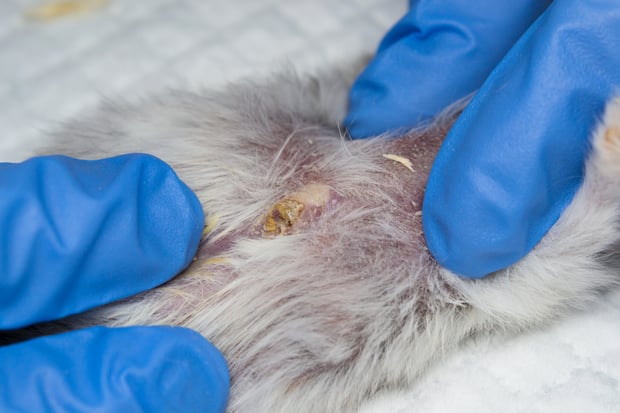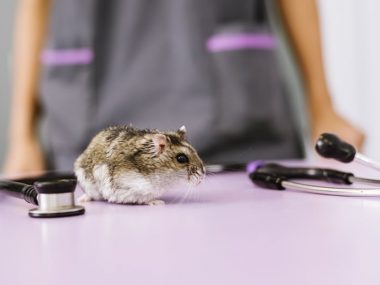Any lumps and bumps on your hamster’s skin must be closely monitored as a tiny injury can quickly develop into something more serious. Skin infections are a relatively common hamster condition, and they can make your little hammie really uncomfortable or can even be fatal if it goes untreated.
Hamster skin infections are caused when parasites, bacteria, or fungus get under the skin. Common skin conditions include abscesses, mites, and ringworm. Skin inflammation may also result from allergic reactions. A veterinarian must be consulted to diagnose and devise a treatment plan.
We all want our hamsters to be cute-looking fluff-balls with healthy fur. If you see (or feel) anything different on your hammie’s skin, it always warrants closer inspection.
Table of Contents
What Causes Skin Diseases In Hamsters?
Your hamster may get a skin infection from something as simple as an infected flea bite, or there could be a pus-filled abscess lurking just below the surface. There is no single cause, and holistic treatment must include addressing the cause and treating the infection.
While some skin infections are preventable, others result from injuries or allergic responses. It may also be that your hamster has some other illness or disorder and the visible skin issues, like hair loss, are just one of the symptoms.
According to MSD Veterinary Manual, most skin disorders that commonly affect hamsters are caused by parasites or bacterial infections. Any condition that manifests on the skin, either as sores or hair loss, should be checked by a vet immediately.
Most Common Hamster Skin Conditions
If you notice that your hammie has a visible sore, raw patches, or is itching more than usual, swift action is required. Let’s go through some common skin conditions that affect hamsters.
- Skin Abscesses – Hamsters are active little pets that run about and burrow down into their bedding. Hamsters’ soft feet or cheek pouches sometimes pick up splinters from hard wood products, creating abscesses. Tiny nicks and cuts from wood bedding or sharp objects in the cage may get infected and cause a bacterial infection.
Choosing the correct bedding for your hamster cage can go a long way in keeping your little pet comfortable and preventing possible skin conditions.
Abscesses usually need to be surgically drained and followed up with an antibiotic to prevent any residual infection.

- Ringworm – Ringworm isn’t a worm at all. It is a fungus that causes unpleasant, itchy spots that look red around the edges.
Treatment usually involves topical antifungal agents. Ringworm is unfortunately contagious to humans and other animals, so be sure to wear gloves while handling your hammie while it is recovering.
- Skin parasites – When a hamster has mites, its skin becomes inflamed and scaly. Bald patches may appear, especially down its back and rump. A veterinarian will confirm the presence of mites with a skin scraping. Mange is contagious and can spread to other animals through direct contact or infected bedding.
While fleas are not a common hamster problem, infestations do occasionally occur. Flea bites cause inflammation and skin irritation. As the hammie tries to soothe the fleabites by licking and chewing, the skin becomes raw and may cause sores and hair loss.
- Allergic contact dermatitis – Your hamster may be allergic to its bedding or something in its cage, which can cause the skin to itch and swell. This is often particularly noticeable on a hamster’s feet which are in direct contact with everything.
- Skin Tumors – Tumors that are visible on a hamster’s skin are not technically an infection like an abscess. A tumor is an overgrowth of cells in a particular area, and the mass needs to be inspected to determine if it is benign or malignant. Skin growths may be visible, but tumors do not contain pus and infection.
How Do You Treat A Hamster’s Skin Infection?
Skin infections can be signs of several diseases and have a range of causes. A precise diagnosis must be made by a veterinarian so that the correct treatment can start as soon as possible. A well-meaning hamster owner may not be able to tell the difference between a parasitic and fungal infection.
In particular, an abscess will need swift medical intervention to prevent pain and suffering as bacterial infections can get very messy if left untreated.
There are some dos and don’ts for hamster owners if you notice any excessive itching, creepy crawlies, hair loss, or feel lumps on your hamster’s skin.
| What To Do | What Not To Do |
|---|---|
| Make an appointment for your hamster to be examined by a veterinarian | Do not start treating your hamster with anything before you have confirmed the diagnosis |
| Make a list of anything that has recently changed in your hamster’s environment, e.g., new bedding, food, cage mate, so you provide the veterinarian with a complete picture | Do not bathe your hamster with any medicated shampoos unless specifically directed to do so by your veterinarian. The animal may die of stress. |
| Quarantine your hamster from others | Never ignore skin irritations and assume the condition will improve on its own. |
| Wear gloves or wash your hands carefully when handling your hamster | Do not apply any antibiotic-based ointments to sores on your hamster without checking with your veterinarian that they are safe to use. |
| Thoroughly clean the cage, change the bedding and sanitize all bowls and water drinkers. | |
| Replace cedar shavings with hypoallergenic bedding |
Can Hamsters Get Eczema?
Eczema is a term used to describe any number of skin conditions that can cause irritation and inflammation. It is, therefore, entirely possible for hamsters to get eczema from mite infestations, flea bites, or ringworm – anytime there are creepy crawlies about, itchy skin irritations are an inevitable result.
Allergies can also cause eczema. Common culprits when hamsters are concerned are cedar shavings. Skin contact with an allergen, called allergic contact dermatitis, will cause skin to react and swell.
An itchy hamster is uncomfortable. While it is normal for a hamster to scratch occasionally, the situation needs to be investigated immediately when it becomes excessive.
How Do You Treat Sores On Hamsters?
Tiny injuries or bite marks on your hamster can cause small sores. If these become infected, they form skin abscesses. However, a sore on your hamster’s skin may also be a cyst or tumor, so an accurate diagnosis is vital to ensure appropriate treatment.
Sometimes, for small sores, you can dab on a small amount of a topical antiseptic, like betadine. This is particularly useful if a sore has been caused by a known cause. For example, if your hamster rubs against its cage, which has caused skin inflammation in a specific area.
Remember that you won’t be able to apply a lot of ointment because the hamster will inevitably groom it off immediately. Hamsters, especially tiny ones like dwarf hamsters, are also notoriously difficult to hold while treating. Discomfort and fear may even make your usually docile hamster bite.
Let’s go through the steps to treat minor wounds on your hamster’s skin.
- Do everything possible to provide your hamster with a comfortable, stress-free environment where it can heal itself as much as possible. Provide plenty of nutritious food, keep the cage clean and add a sand bath so your hammie can roll about and keep itself clean naturally.
- Rinse the sore using a sterile saline solution. Use a small syringe to gently direct saline onto the sore spot. Keep patting it dry and reapplying until the sore is thoroughly clean.
- Use a Q-tip to dab a tiny spot of topical antiseptic cream onto the sore.
- Note any changes, and if the sore doesn’t heal or there is any deterioration, get it checked out.
Conclusion
Hamster skin infections are relatively common. Skin problems result from abscesses, allergies, parasites, or fungal infections. Owners should always unhealthy-looking skin seriously, and an accurate diagnosis must be made before starting a treatment plan. There is absolutely no substitute for a trip to a veterinarian.






